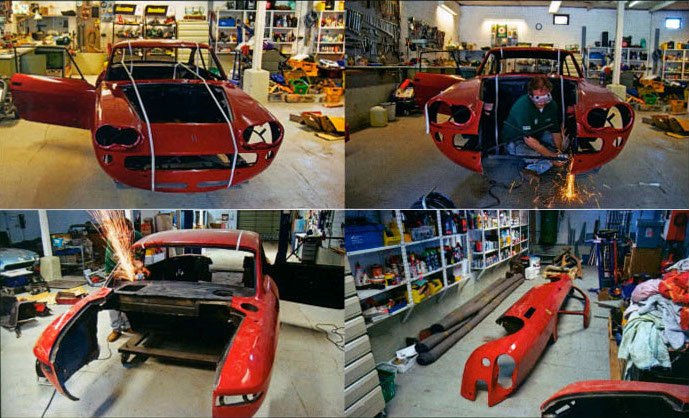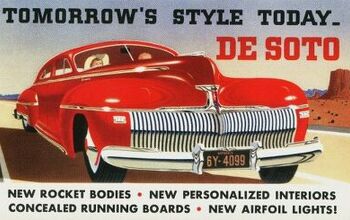What's Wrong With This Picture? Ferraris For Art's Sake Edition

Start cutting into the wrong car and you’re likely to get hate mail from brand purists. When Jesse James’ old Monster Garage show turned a fairly rare 1971 Chevy El Camino SS into a Figure 8 race car, the producers wouldn’t tell the seller what their plans were for fear of queering the deal. Now Figure 8, being a step above demo derby, is admittedly not exactly a concours, but Chevy cowboy Cadillacs are not quite as rare as hens’ teeth. There were 44,606 El Caminos produced in 1971. I remember something guitar dealer and trader George Gruhn said to me about $25,000 Fender Strats and $50,000 Gibson Les Pauls (paraphrased), “Remember, they were built in factories, on assembly lines, by Mexican American immigrant women, not by artisans like Cremona violins.”
On one hand, it’s wrong to waste something. My zayde was a junkman who raised a family of five daughters and two nephews dealing in scrap paper and rags. On the other, I’m sure that while he occasionally brought home an unexpected find amidst the rags, it’s quite likely that in his day to day business he bundled up and sold what would now be collectible and possibly valuable items of ephemera, without giving it a second thought. Every day recyclers smelt objects that have value beyond that of scrap. So it goes.
“Ghost signs” are old advertisements painted on walls exposed when newer adjacent buildings are torn down, revealing the old ads once again. There’s one for Champion Spark Plugs on Woodward near Seven Mile in Detroit. Since being exposed it’s been gradually painted over by new ads. Part of me mourns the loss of some cool commercial art. The other part says that today’s ads generate wealth and the Champion ad was no less commercial than they are, though, to be honest, I liked its aesthetics better than a knockoff Sponge Bob Squarepants hawking party rentals. Ultimately, though, the owner of property has the right to do whatever they want to do with it, even cut it up for the sake of art.
The Hamburg artists say that aesthetics is one of their motivations. Another is paying homage to Ferrari and to Pininfarina who designed those bodies. They say that many collectible cars are works of art that are too often hidden away in warehouses and garages.
A classic Ferrari is more than a viable sports car. Seen from an aesthetic angle it is primarily an object of art. The constantly rising prices paid by collectors impressively confirm this – as do art exhibitions worldwide. It is almost certainly no coincidence, that the renowned New York Museum of Art chose a 1960s Ferrari as its first automotive exhibit.
Sadly these jewels are usually condemned to a life in dark and dusky garages instead of being admired in an inviting ambience.
Keeping with the focus on aesthetics and design, Eigel and Ulmer use only the body panels, leaving off any trim, lights, mirrors or wheels.
The results are unique objects of art, which fascinate particularly because the clear and simple shapes created by legendary Ferrari designer Pininfarina have been brought out beautifully.
So why destroy a perfectly serviceable (and very valuable) car body? Ulmer says,
“Only the original possesses the aura of Pininfarina’s design, to whom this is an homage.”
Perhaps there’s more than a touch of modern art’s fascination with the transgressive in the Ferrari Project but they do have a point. Mega car dealer, race team owner and noted car collector Rick Hendricks, when asked about resto-mods and “tribute” cars or clones of rare muscle cars getting serious money at auction, said that one reason is that the originals are just too valuable to drive and risk damage or destruction. Ken Lingenfelter has battery tenders on 99% of the cars in his collection just so that they can be driven regularly, but he admitted that a handful are so rare and essentially irreplaceable that they can’t practically be driven on public roads. A Ferrari in storage may appreciate in monetary value but hardly anyone gets to appreciate it.
To their credit, the artists didn’t cut up functioning cars. In both cases they tracked down bodies that had been removed from their production chassis and were just sitting collecting dust in storage, and recalling George Gruen’s remark, neither car is ultra-rare. About 1,000 Ferrari 365GTs were made and about 1,100 330GTs were produced. Ulmer and Eigel have announced that they will be taking commissions for future wallhangings of specific models. It remains to be seen whether they’ll recover other unused bodies, salvage panels from wrecks, or if they’ll transgressively take a Sawzall to a Ferrari that was running when parked (or, if they’ll work with other marques as their media). In any case, though, they are emulating Enzo Ferrari in the way they do business.
Interested persons, who would like to know the prices of these unusual wall decorations, will be invited to a chat face-to-face. “We handle this just like Enzo Ferrari, when a unique model was ordered”, says Jürgen Ulmer in recognition of the great creator of the artwork’s basis: “The Commendatore used to utter these things over a glass of good red wine.”
Speaking of prices, Ars may be Gratia Artis but something tells me that each Ferrari Project wall hanging will be priced significantly higher than 50% of the market value of each of those complete Ferrari bodies.
Ronnie Schreiber edits Cars In Depth, a realistic perspective on cars & car culture and the original 3D car site. If you found this post worthwhile, you can dig deeper at Cars In Depth. If the 3D thing freaks you out, don’t worry, all the photo and video players in use at the site have mono options. Thanks – RJS

Ronnie Schreiber edits Cars In Depth, the original 3D car site.
More by Ronnie Schreiber
Latest Car Reviews
Read moreLatest Product Reviews
Read moreRecent Comments
- UnoGeeks Great information. Unogeeks is the top SAP ABAP Training Institute, which provides the best SAP ABAP Training
- ToolGuy This thing here is interesting.For example, I can select "Historical" and "EV stock" and "Cars" and "USA" and see how many BEVs and PHEVs were on U.S. roads from 2010 to 2023."EV stock share" is also interesting. Or perhaps you prefer "EV sales share".If you are in the U.S., whatever you do, do not select "World" in the 'Region' dropdown. It might blow your small insular mind. 😉
- ToolGuy This podcast was pretty interesting. I listened to it this morning, and now I am commenting. Listened to the podcast, now commenting on the podcast. See how this works? LOL.
- VoGhost If you want this to succeed, enlarge the battery and make the vehicle in Spartanburg so you buyers get the $7,500 discount.
- Jeff Look at the the 65 and 66 Pontiacs some of the most beautiful and well made Pontiacs. 66 Olds Toronado and 67 Cadillac Eldorado were beautiful as well. Mercury had some really nice looking cars during the 60s as well. The 69 thru 72 Grand Prix were nice along with the first generation of Monte Carlo 70 thru 72. Midsize GM cars were nice as well.The 69s were still good but the cheapening started in 68. Even the 70s GMs were good but fit and finish took a dive especially the interiors with more plastics and more shared interiors.





































Comments
Join the conversation
As an artist I'm quite familiar with stuff like this, its "Modern Art" where some one will basically take something, hang it up, and call it "art". I like to call it "A way of making art without using any talent whatsoever", as Modern Art has become popular to both hipsters (idiots that love things only because they're different) and who I call "Bums", people that want things to be exteremely easy and expect other people to have no standards. This isn't art, its just something thats stuck on a wall.
Does anyone have anymore info on the Camino Monster garage stuff? I'd like to read about it, and maybe why they specifically chose an SS.